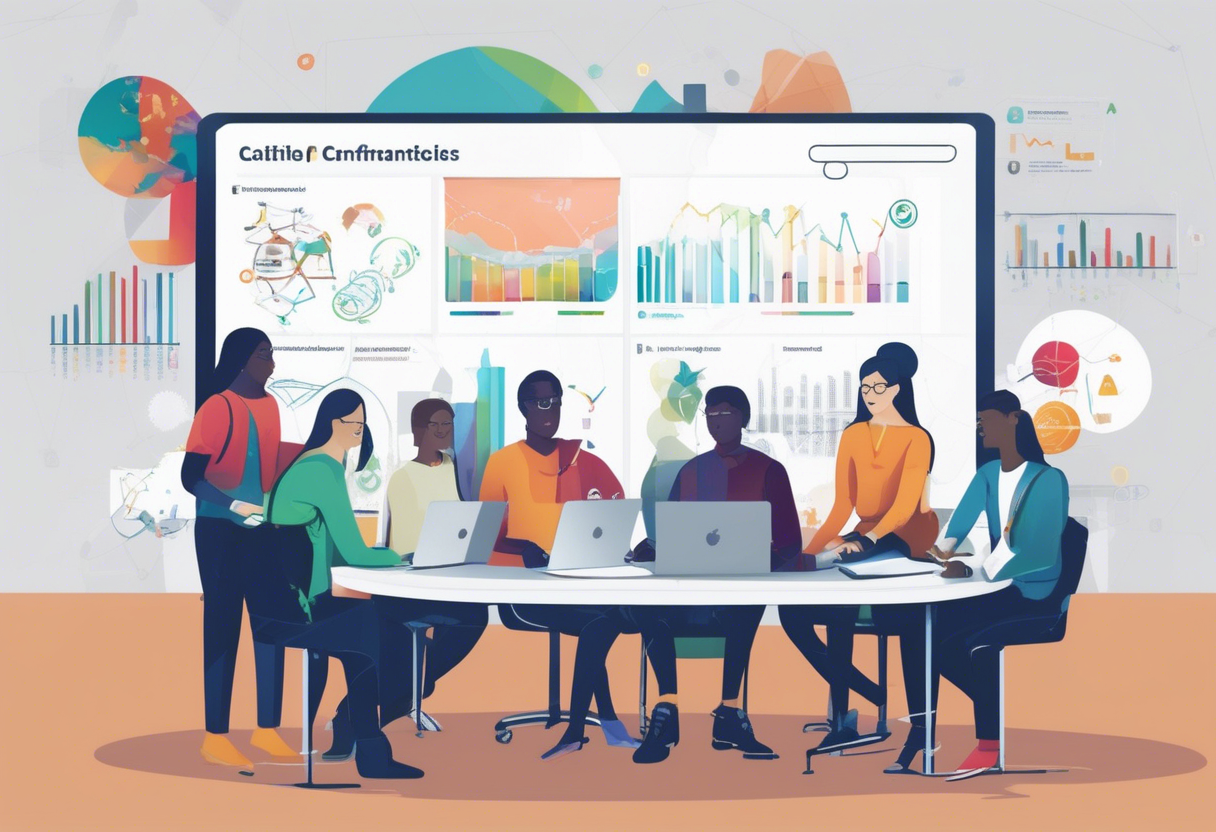Technology is changing fast, and it's everywhere. STEM education is a big deal for getting people ready for work. Jobs in STEM fields are expected to grow by 8% by 2029, which is faster than most other jobs. This growth shows we need to close the gap in STEM skills and get people ready for the future. STEM education helps with a lot, like fixing shortages in skilled workers and boosting creativity and problem-solving. It's key to a strong economy. From early education programs to using new tech, STEM is the way to build a successful workforce. Let's look at how investing in STEM education is changing industries and helping the next wave of inventors!
Summary: This article discusses the significance of STEM education in workforce development, addressing the STEM skills gap, and providing case studies of successful initiatives. It also explores the role of early STEM education and innovative technologies in enhancing workforce capabilities.
The Importance of STEM Education in Workforce Development
STEM's Impact on Economic Growth
STEM—short for Science, Technology, Engineering, and Mathematics—plays a significant role in boosting the economy by preparing workers to solve complex problems. This type of education sparks innovation and entrepreneurship, which are key to starting new industries and creating jobs. Countries like South Korea and Germany have experienced major economic gains by focusing on STEM, building a workforce that can keep up with technological advances and compete globally.
STEM education is crucial for staying competitive in fields such as advanced manufacturing, IT, biotech, and clean energy. These sectors contribute significantly to the GDP and offer fast-growing, well-paying jobs. Thus, acquiring STEM skills is essential for anyone looking to dive into these exciting areas. It fuels innovation, economic growth, and even national security. The National Science Foundation highlights the importance of building a strong STEM workforce.

Future Workforce Skills: The STEM Advantage
STEM education prepares students for in-demand careers in engineering, computer science, and healthcare. It is key to closing workforce gaps in rapidly evolving fields like AI, cybersecurity, and environmental science. Additionally, it enhances critical thinking, problem-solving, and teamwork skills, which are indispensable for tomorrow’s jobs. These skills form the backbone of STEM learning and are crucial for tackling complex challenges in various industries. The National Society of High School Scholars stresses the importance of these skills.
Building Technological Proficiency
As digital transformation accelerates, being tech-savvy is more important than ever. STEM education builds digital skills and adaptability, preparing students for today’s jobs. Skills in coding, software development, and cybersecurity are especially in demand. Companies need individuals who can build and manage digital systems, ensuring smooth and secure operations. Programming languages like Python, Java, and C++ are essential across many fields, from finance to healthcare.
Enhancing Data Literacy
In a world awash with data, the ability to understand and utilize data insights is invaluable. Data literacy involves understanding data sources, methods, and analysis tools. Professionals skilled in data science and analytics can help businesses make informed decisions, improve processes, and drive strategies. Tools like Tableau, R, and SQL are commonly used for data analysis and visualization, making them vital for data-driven decision-making.
Fostering Innovation and Creativity
STEM education encourages innovation and creativity, pushing individuals to think differently and develop new solutions. This mindset is vital in industries facing rapid technological changes. Fostering creativity in STEM can lead to breakthroughs that transform industries and create new opportunities. Companies value employees who can innovate, adapt, and contribute to long-term success.
By investing in STEM education, societies can equip their workforce with the skills needed to thrive in a fast-changing world, ensuring steady economic growth and resilience. The need to integrate STEM education with workforce development is emphasized in the Uniting STEM Education and Workforce PDF.
Closing the STEM Skills Gap for Workforce Development
Analyzing the STEM Skills Gap Impact on Workforce Development
There's a significant skills gap in STEM fields because the skills that employers require often don't align with what workers possess. This mismatch is exacerbated by challenges related to diversity and inclusion. As technology rapidly advances, there is a high demand for skills in data analysis, AI, and software development. However, many educational institutions and training programs struggle to keep pace, resulting in a shortage of qualified candidates.
Moreover, students are missing out on essential soft skills such as critical thinking, problem-solving, and communication. This gap is partly due to learning loss and an over-reliance on technological shortcuts. When combined with the high cost of education and a lack of resources in underfunded schools, many individuals are unable to access the quality STEM education they need. Consequently, a significant number of potential professionals lack the skills necessary to enter the workforce.

STEM fields evolve rapidly, necessitating continuous learning of new skills. Unfortunately, many education systems and training programs are not adequately addressing this challenge.
Effective Strategies for Workforce Development in STEM
Addressing the STEM skills gap requires collaboration among employers, educators, and the government. One effective strategy is to create clear pathways to STEM careers through apprenticeships, T-Levels, and degree apprenticeships. These initiatives equip students with the skills needed for emerging technologies.
Upskilling and reskilling current employees through flexible training, inclusive hiring, and diversity initiatives can help fill immediate talent gaps and support underrepresented groups. Work-based learning opportunities, such as apprenticeships and mentorships, connect academic learning with real-world STEM applications, enhancing workforce readiness.
Partnerships between industries and educational institutions are crucial in developing relevant curricula and providing hands-on training. For example, companies like Yaskawa Motoman collaborate with educational programs to create Industry 4.0-aligned curricula, preparing workers for modern manufacturing environments.
Innovative credentialing methods, such as micro-credentials and modular education, allow learners to build skills incrementally, adapting to rapid changes in STEM. Additionally, technology tools like AI platforms and virtual reality facilitate continuous learning, ensuring that workers remain up-to-date.
In summary, addressing the STEM skills gap involves enhancing STEM education, promoting diversity and inclusion, and prioritizing lifelong learning. By doing so, we can cultivate a robust workforce ready to thrive in the ever-evolving STEM landscape.
Successful Workforce Development: Case Studies and Examples
Corporate STEM Workforce Development Initiatives
Companies are taking the lead in boosting STEM skills and driving digital growth. They're setting up robotics contests and offering hands-on computer science lessons to engage young people and prepare them for the job market. Big names in industries like automotive and IT are rolling out training programs that provide real-world work experience, setting individuals up for solid careers.
Businesses are also collaborating with training providers to create custom programs that help employees acquire new skills, close knowledge gaps, increase productivity, and improve retention. A notable example is Think Employment, which partners with companies to design training that results in noticeable boosts in productivity and employee retention.

Regional and Governmental STEM Workforce Investments
Local workforce boards and government bodies are joining forces with community groups and industries to create job programs tailored to local needs. These partnerships with local governments and public funders provide focused workforce solutions that help regional economies grow and meet local skill demands. Workforce Solutions of Central Texas is a prime example, working with various groups to tailor programs to local job needs, including special support for veterans.
Government efforts focus on broadening computer science access, developing talent for mid-level jobs, and building lasting talent pipelines in areas like renewable energy. The San Diego Workforce Partnership showcases creative, adaptable training in renewable energy and IT, emphasizing real-world learning that leads to meaningful employment.
Real-World Workforce Development Success Stories
The Colorado Workforce Development Council shares a variety of case studies that highlight local best practices, upskilling efforts, workforce innovation, and the shift to remote work. These stories demonstrate how communities and partners can scale up workforce development.
In healthcare, the San Luis Valley Regional Medical Center recruits non-traditional candidates and provides structured training, producing certified surgical technologists and sterile processing technicians. This approach boosts retention and strengthens the local economy.
Additionally, Amazon's Technical Academy trains non-technical frontline workers for software engineering roles, offering career growth and helping fill skill gaps. Microsoft's skill-based reskilling strategy emphasizes workforce flexibility through employee development, encouraging ongoing learning to drive innovation and maintain industry leadership.

These efforts by businesses and governments, along with successful case studies, play a crucial role in building a strong STEM workforce, ensuring people are prepared for the fast-changing tech world.
The Role of Early STEM Education in Workforce Development
Benefits of Early STEM Exposure for Workforce Skills
Getting kids into STEM (Science, Technology, Engineering, and Mathematics) early sets them up with skills they'll use for life. It's more than just learning facts; it's about thinking critically, solving problems, and getting hands-on. These skills are key in jobs like engineering and healthcare, where they're in high demand. Plus, STEM drives tech innovations, pushing forward things like medical advances and renewable energy.
Starting with STEM young can spark a lifelong love of learning. Whether they're checking out science experiments, tinkering with engineering ideas, or playing with math puzzles, kids get curious about the world. This curiosity often leads them to STEM careers, which are not only in demand but also pay well. Research from Purdue University shows that many adults in STEM jobs got their start with these subjects in elementary school.
Another perk is learning to work with others. STEM often involves group work, teaching kids teamwork and communication. These skills are gold in the workplace. Early STEM learning also breaks down gender stereotypes, encouraging more girls to enter fields traditionally dominated by men, helping to create a more diverse workforce.
Regional Success Stories in Early STEM Education
Schools that roll out solid STEM programs see kids more engaged and better at solving problems. Early STEM in elementary schools builds a base for lifelong learning and success by showing how different subjects connect in real life.
In the U.S., projects like EDC's Ford Next Generation Learning project link high schools with employers to make sure students are ready for work by including real-world learning. Other efforts, like bringing AI literacy to community colleges and Data Paths in K-12 schools, give students practical STEM skills that match what jobs need.
These examples highlight how early STEM education can shape a workforce ready for future challenges. By building critical skills and a strong talent pool, early STEM education ensures students are ready to succeed in a rapidly changing job market.
Innovative Technologies in STEM Workforce Development
Transformative Technologies in STEM Education
STEM education is evolving rapidly due to innovative technologies that make learning more engaging and prepare students for future careers. Programs such as robotics, coding camps, and science competitions in K-12 schools are pivotal. They ignite interest and develop essential skills early, establishing a robust STEM foundation for addressing future challenges.
Emerging technologies like gamification, augmented reality (AR), and virtual reality (VR) are transforming STEM education by making learning more immersive. For instance, VR allows students to explore complex topics such as human anatomy or the solar system in an interactive way. Companies like zSpace and Labster are at the forefront, providing VR tools for virtual experiments and 3D model exploration, enabling students to grasp scientific concepts on a deeper level.

Micro-credentialing and digital badges are gaining traction in colleges and workplaces. These tools validate skills in real-time and align learning with industry needs, such as AI and data science. Universities, employers, and government agencies are collaborating to emphasize skill development that is immersive and problem-specific, creating adaptable STEM professionals. The NSF-funded STEMfolio platform exemplifies this approach. It aids young individuals in building digital portfolios to showcase their STEM skills and connect with job opportunities.
Preparing for Future STEM Workforce Needs
As technology advances, the demand for skilled workers in emerging STEM fields is increasing. By 2030, the U.S. may face a shortage of 1.4 million STEM jobs, making workforce development crucial for maintaining global innovation and competitiveness. Ontario is proactively addressing this by investing $750 million to create 20,500 new postsecondary STEM seats annually. The focus is on high-demand sectors like advanced manufacturing, clean tech, cybersecurity, AI, and data science.
Partnerships between educational institutions and industries are essential to ensure curricula remain aligned with technological trends and employer needs, particularly in interdisciplinary fields. Programs like NSF's Innovations in Graduate Education (IGE) promote interdisciplinary learning, real-world problem-solving, and leadership skills to prepare STEM workers for global challenges. Addressing the STEM talent gap involves expanding access to STEM education for underrepresented groups and enhancing early exposure to emerging technologies like AI, robotics, and renewable energy.
Integrating these technologies and strategies into STEM education not only equips students with essential skills but also inspires them to pursue careers in fields crucial for our future economy.
FAQ Section on Workforce Development in STEM
Ensuring Inclusive and Equitable STEM Education
Making STEM education inclusive and fair is crucial. We need to tackle the barriers to access, participation, and success for all students. One way is to offer low-cost options so everyone, no matter their financial background, can take STEM courses. This could mean providing free or affordable resources, like online courses and open-access materials, that students from all walks of life can use. For more information, check out this source.
It's also important to listen to students, families, and communities. By doing this, schools can create STEM programs that fit the needs and interests of diverse students. This approach can make the curriculum more engaging and relevant, boosting participation and success in STEM fields. Learn more from this source.
Impact of Apprenticeships and Internships on STEM Workforce Development
Apprenticeships and internships are key in shaping the future STEM workforce. They provide students with hands-on experience and help them build a portfolio of relevant work. These programs connect education with industry, preparing students for the job market by letting them apply what they’ve learned in real-world settings. Explore further details in this source.

Internships, which are usually shorter, let students explore different STEM careers, helping them make informed choices about their futures. Companies often use internships to spot and nurture talent, sometimes offering jobs to standout participants.
Apprenticeships are more structured and longer, mixing on-the-job training with classroom learning. This is especially effective in fields like engineering and IT, where technical skills are crucial. Through apprenticeships, individuals gain specific industry skills and develop a strong work ethic.
Both apprenticeships and internships help fill the skills gap and prepare graduates to meet job market demands. They often focus on underrepresented groups, aiming to diversify the STEM workforce and promote fairness.
Effective Collaboration Between Industry and Academia to Bridge STEM Skills Gap
Industry and academia need to team up to tackle the STEM skills gap. They can work together through joint research projects, public-private partnerships, and industry-sponsored fellowships. These collaborations allow them to share resources and expertise, sparking innovation and giving students and faculty practical research experience. For more insights, see this source.

Aligning education with industry needs is also crucial. This can be done by co-developing curricula and incorporating experiential learning, ensuring academic programs keep pace with technological advances and industry demands. This way, graduates are ready to dive into the workforce right after graduation. Additional details are available in this source.
Partnerships can also include guest lectures and workshops where industry pros share their insights with students. These sessions give students a real-world perspective, complementing their academic learning and showing them how their studies apply in practice. Advisory boards with industry representatives can keep academic programs current by providing feedback on curriculum development.
By fostering collaboration, industry and academia can develop a skilled STEM workforce ready for future challenges.